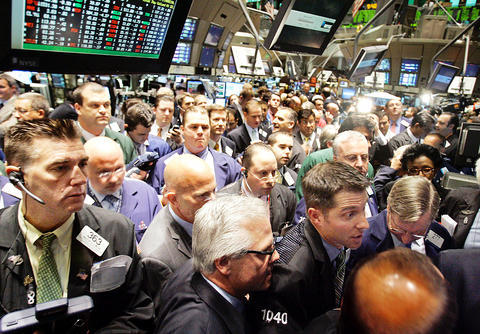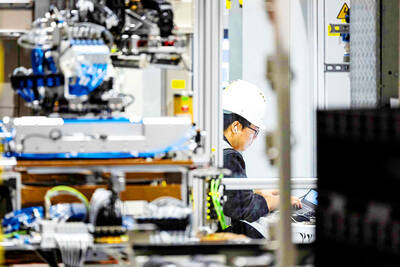After months of hype, hoopla and no small amount of controversy, the Blackstone Group went public on Friday, and with it, lost its "private equity" status.
Its shares, whose symbol is BX -- as in bucks -- was clearly a success. The offering -- priced at US$31, the high end of the expected range -- opened 18 percent higher at US$36.55 and ended trading at US$35.06
The opening was treated almost like a Hollywood premiere at the New York Stock Exchange, where television trucks from networks around the world lined up to report the offering, the biggest on Wall Street and the most high profile since Google went public in 2004.

PHOTO: AP
Blackstone chief executive Stephen Schwarzman, who has attracted much criticism in recent weeks amid the unwanted attention that the stock offering has put on the industry, was not in attendance.
But Tom Wolfe, the author of The Bonfire of the Vanities, was. Walking the floor of the exchange just before the opening, he told a CNBC reporter: "We may be witnessing the end of capitalism as we know it."
Still, the successful offering could presage a wave of followers among private equity firms. Kohlberg Kravis Roberts is considering an offering, as is the Apollo Group.
The stock offering came the same day that more than a dozen Democrats introduced legislation to increase the tax on "carried interest," the performance income earned by many partnerships, including private equity firms. The tax would rise to the ordinary income tax rate of 35 percent, up from the 15 percent capital gains rate now in place. Last week, a bipartisan bill was introduced to increase taxes on firms like Blackstone. Some had speculated that the bill would kill Blackstone's offering or at least lower its valuation, but it appeared to do neither.
Blackstone's offering did not pop the way Fortress Investment Group's offering did in February. That offer surged 68 percent, to US$31, after it raised US$634 million. Those shares have fallen 20 percent since, in part on worries about the possible impact of increased taxes.
With the help of an army of underwriters, 17 in all, Blackstone sold 133.3 million common shares, or a 12.3 percent stake. The company has already sold a US$3 billion nonvoting stake to a Chinese state-owned investment company.
The firm, which started in 1985 with just US$400,000, had a market value of US$38 billion at the close of trading on Friday, giving it a higher market value than more established financial players like Bear Stearns, the investment bank.
No one will reap more from the offering than Blackstone's two founders. With a 24 percent position in the firm, Schwarzman will hold a US$7.7 billion stake and could earn up to US$677 million from the offering's proceeds. That is on top of the nearly US$400 million in compensation he took home last year.
The firm's chairman, Peter Peterson, who is retiring, will earn US$1.88 billion from the offering and will retain a 4 percent stake.

CHIP RACE: Three years of overbroad export controls drove foreign competitors to pursue their own AI chips, and ‘cost US taxpayers billions of dollars,’ Nvidia said China has figured out the US strategy for allowing it to buy Nvidia Corp’s H200s and is rejecting the artificial intelligence (AI) chip in favor of domestically developed semiconductors, White House AI adviser David Sacks said, citing news reports. US President Donald Trump on Monday said that he would allow shipments of Nvidia’s H200 chips to China, part of an administration effort backed by Sacks to challenge Chinese tech champions such as Huawei Technologies Co (華為) by bringing US competition to their home market. On Friday, Sacks signaled that he was uncertain about whether that approach would work. “They’re rejecting our chips,” Sacks

NATIONAL SECURITY: Intel’s testing of ACM tools despite US government control ‘highlights egregious gaps in US technology protection policies,’ a former official said Chipmaker Intel Corp has tested chipmaking tools this year from a toolmaker with deep roots in China and two overseas units that were targeted by US sanctions, according to two sources with direct knowledge of the matter. Intel, which fended off calls for its CEO’s resignation from US President Donald Trump in August over his alleged ties to China, got the tools from ACM Research Inc, a Fremont, California-based producer of chipmaking equipment. Two of ACM’s units, based in Shanghai and South Korea, were among a number of firms barred last year from receiving US technology over claims they have

It is challenging to build infrastructure in much of Europe. Constrained budgets and polarized politics tend to undermine long-term projects, forcing officials to react to emergencies rather than plan for the future. Not in Austria. Today, the country is to officially open its Koralmbahn tunnel, the 5.9 billion euro (US$6.9 billion) centerpiece of a groundbreaking new railway that will eventually run from Poland’s Baltic coast to the Adriatic Sea, transforming travel within Austria and positioning the Alpine nation at the forefront of logistics in Europe. “It is Austria’s biggest socio-economic experiment in over a century,” said Eric Kirschner, an economist at Graz-based Joanneum

France is developing domestic production of electric vehicle (EV) batteries with an eye on industrial independence, but Asian experts are proving key in launching operations. In the Verkor factory outside the northern city of Dunkirk, which was inaugurated on Thursday, foreign specialists, notably from South Korea and Malaysia, are training the local staff. Verkor is the third battery gigafactory to open in northern France in a region that has become known as “Battery Valley.” At the Automotive Energy Supply Corp (AESC) factory near the city of Douai, where production has been under way for several months, Chinese engineers and technicians supervise French recruits. “They